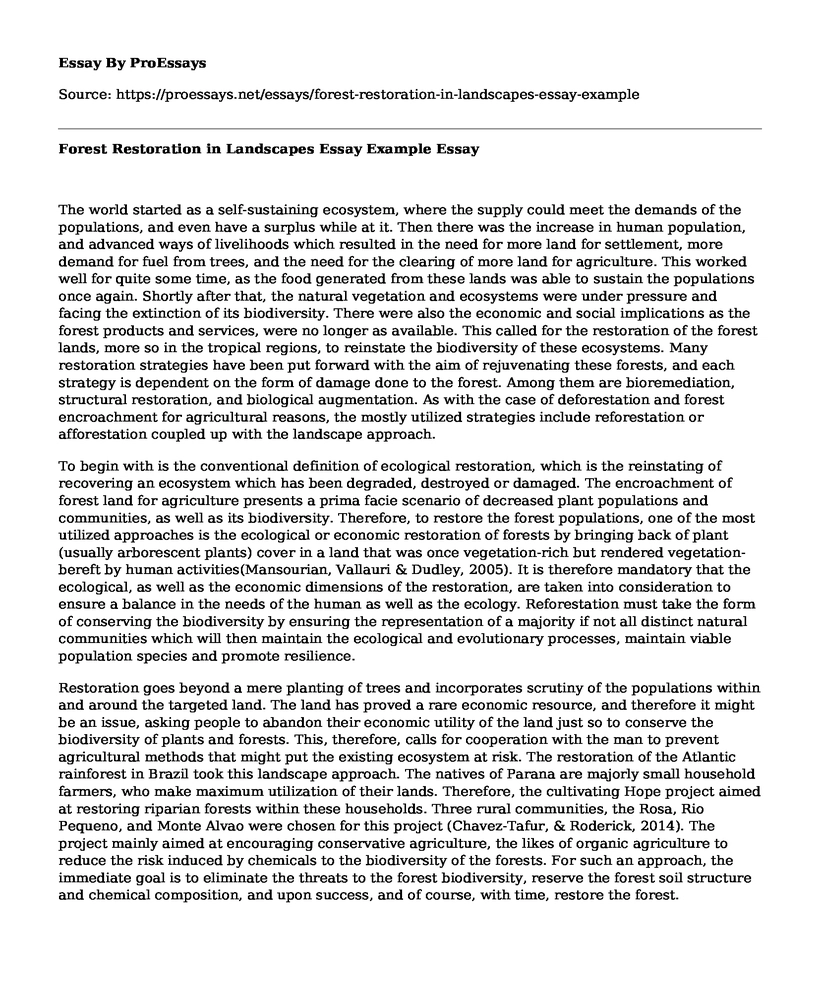The world started as a self-sustaining ecosystem, where the supply could meet the demands of the populations, and even have a surplus while at it. Then there was the increase in human population, and advanced ways of livelihoods which resulted in the need for more land for settlement, more demand for fuel from trees, and the need for the clearing of more land for agriculture. This worked well for quite some time, as the food generated from these lands was able to sustain the populations once again. Shortly after that, the natural vegetation and ecosystems were under pressure and facing the extinction of its biodiversity. There were also the economic and social implications as the forest products and services, were no longer as available. This called for the restoration of the forest lands, more so in the tropical regions, to reinstate the biodiversity of these ecosystems. Many restoration strategies have been put forward with the aim of rejuvenating these forests, and each strategy is dependent on the form of damage done to the forest. Among them are bioremediation, structural restoration, and biological augmentation. As with the case of deforestation and forest encroachment for agricultural reasons, the mostly utilized strategies include reforestation or afforestation coupled up with the landscape approach.
To begin with is the conventional definition of ecological restoration, which is the reinstating of recovering an ecosystem which has been degraded, destroyed or damaged. The encroachment of forest land for agriculture presents a prima facie scenario of decreased plant populations and communities, as well as its biodiversity. Therefore, to restore the forest populations, one of the most utilized approaches is the ecological or economic restoration of forests by bringing back of plant (usually arborescent plants) cover in a land that was once vegetation-rich but rendered vegetation-bereft by human activities(Mansourian, Vallauri & Dudley, 2005). It is therefore mandatory that the ecological, as well as the economic dimensions of the restoration, are taken into consideration to ensure a balance in the needs of the human as well as the ecology. Reforestation must take the form of conserving the biodiversity by ensuring the representation of a majority if not all distinct natural communities which will then maintain the ecological and evolutionary processes, maintain viable population species and promote resilience.
Restoration goes beyond a mere planting of trees and incorporates scrutiny of the populations within and around the targeted land. The land has proved a rare economic resource, and therefore it might be an issue, asking people to abandon their economic utility of the land just so to conserve the biodiversity of plants and forests. This, therefore, calls for cooperation with the man to prevent agricultural methods that might put the existing ecosystem at risk. The restoration of the Atlantic rainforest in Brazil took this landscape approach. The natives of Parana are majorly small household farmers, who make maximum utilization of their lands. Therefore, the cultivating Hope project aimed at restoring riparian forests within these households. Three rural communities, the Rosa, Rio Pequeno, and Monte Alvao were chosen for this project (Chavez-Tafur, & Roderick, 2014). The project mainly aimed at encouraging conservative agriculture, the likes of organic agriculture to reduce the risk induced by chemicals to the biodiversity of the forests. For such an approach, the immediate goal is to eliminate the threats to the forest biodiversity, reserve the forest soil structure and chemical composition, and upon success, and of course, with time, restore the forest.
Conclusion
Reforestation is expensive to many organizations and governments, one factor that makes it difficult to implement. Its effectiveness and success depend on some factors, the finances factoring in, as well as the species resistance and maturation period. Human beings have for long been the poison to their existence, and it's about time that they undo it. The most immediate impact of forest restoration is the change in human activities, economic and ecological, towards the forest ecosystem. This includes limitation by various forest bodies. The long-term impact is the recovery of forest cover as well as its biodiversity.
References
Chavez-Tafur, J., & Roderick J. Z. (Eds.). (2014). Towards Productive Landscapes. Tropenbos International, Wageningen, the Netherlands. Pp. 1- 224.
Mansourian S., Vallauri D., & Dudley N. (2005). Forest Restoration in Landscapes: Beyond planting trees. Springer. Pp. 3-141
Cite this page
Forest Restoration in Landscapes Essay Example. (2022, Aug 23). Retrieved from https://proessays.net/essays/forest-restoration-in-landscapes-essay-example
If you are the original author of this essay and no longer wish to have it published on the ProEssays website, please click below to request its removal:
- The Perception of Fragmented Landscape by Neotropical Marsupials
- Essay Sample on World Crisis and International Preparedness
- Pyrolysis as a Modeling Approach to Saving Energy Usage - Essay Sample
- Research Paper on Deepsea Rig Accident
- Essay Sample on The Sacred Balance: Rediscovering Our Place in Nature
- Research Paper on Funding Environmental Restoration in Earthquake-Hit Chiapas, Mexico
- Essay Example on Carbon Footprint Accounting: Measuring Greenhouse Gas Emissions







